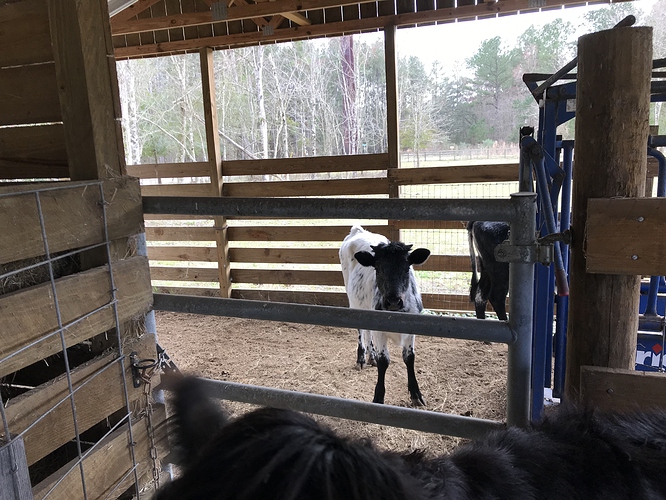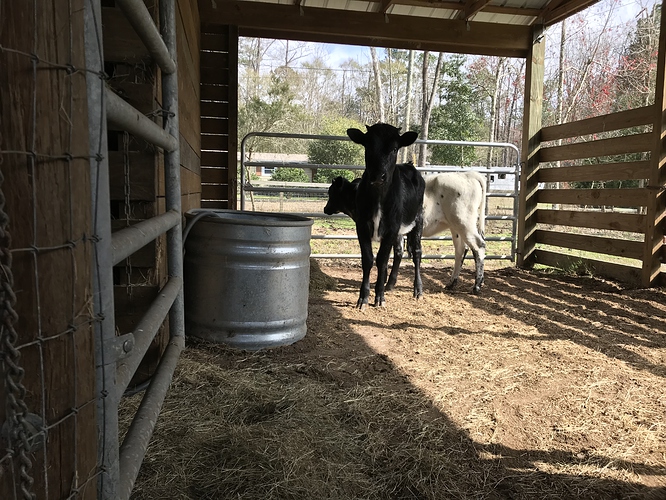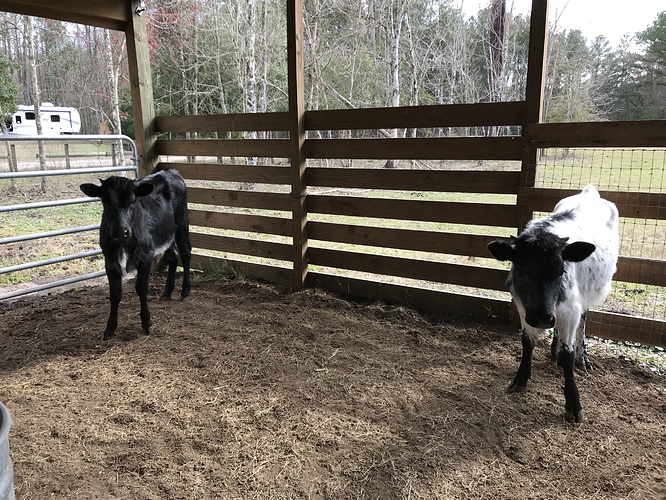I just brought home two heifers. We’ve raised a European breed for many years, but we wanted to try something different. This is a rare 500 year old breed descended from the first cattle brought to Florida by the Spanish. The registry was established by animal science professors at UF from feral herds in state forests. They come in crazy colors and are very resistant to parasites, heat, and flies. I bought two weanling heifers I hope to tame down a bit. They are used to people, but cattle are always suspicious of new people, so they need some time to adjust. Pictures soon!
Names? They’re lovey 
Very pretty girls. Is the genetic basis known for the coat colors? Does the one with the light body have something akin to roaning, or ???
They are cute but boy do they look like if you even thought the word Boo they would be over or thru those fences and gone!
They are pretty reactive, lol! However, I went in with them and they weren’t too bad. No panicking; just scared baby stuff.
The coat colors are all over. Apparently, you never know what the calf will look like. I saw the mama cows and the bull. One momma cow is white with big brown splotches and the other is a brown brindle. The bull is similar to the white calf.
The names haven’t been chosen, yet. At the moment, it’s Tiny and Skittles.
What’s your plan for them and will they have a job? Grass munchers? For meat? For milk?
they are cute.
I’m somewhat familiar with Cracker horses which are reportedly ancestors of Spanish horses also.
Just curious, what prompted you to get these critters?
Really cute baby moo moo’s… I know very little about cows, except I would love to eventually get a couple to watch grazing in my pasture. You are going to have fun with them, them seem very cautious.
Neat! I’ve always loved the crazy colors on some of the older cattle breeds. Are you going to breed them eventually? Those heritage breeds/landraces are so interesting and some of their genetics are so valuable; in this case the parasite/heat resistance.
We raise cattle for beef, but we’d like to establish a seed stock herd to perpetuate the breed. Only the best bulls get a good job while the others go to freezer camp. I have to learn about the different lines and traits associated so we can decide on a bull when the time comes. These babies just need to grow up for about a year. Hopefully, they’ll be tame enough before they calve for the first time. We bred another heritage breed and really enjoyed it. Our lines are still in use and even sought after fo good temperaments, udder shape on the cows, and nice builds. We guessed right when our bull was young and had him collected. We still sell straws every year.
These guys have thrived so long down here and it is important to preserve their genetics. We always raise grass fed beef and to do that well, you stick with heritage breeds that were raised that way for centuries. The flavor of the beef is far superior than modern breeds raised on grass. Modern breeds taste good fed out on grain because they are selected for marbling and flavor based on grain finishing. They can get a strong gamey flavor when finished on a grass based diet. The big unknown for us with Crackers is the flavor of the beef and the quality of the steaks. Based on their build, they steaks will be smaller, of course, but marbling is how they are graded. Those are concerns for marketing the beef. For the immediate future, we will be the main consumers. If we think it’s marketable, we can lease additional pasture (or woodlands with these guys) and expand the herd.
The cool thing about these guys is that they browse as well as graze. They can eat underbrush in a pine forest or farmed pines, which reduces the fire risk. Here in Florida, we get plenty of lightning caused forest fires. Controlled burns are useful, but they put a lot of CO2 into the atmosphere. I think these guys could help reduce underbrush without the smoke issues. Okay, so people might ask about CO2 from the cattle. Funny thing is that greenhouse gases from cattle are based on what they eat. Eating grain is bad, but browsing makes the type of cattle emissions more akin to that of a deer (which are just smaller ruminants). If we could feed people beef, reduce underbrush without so much smoke, and reduce the demand for feedlot cattle, even a little, it would be helpful.
California has experimented with goats to reduce underbrush, but they ought to look into these Cracker cattle because they help just by being bigger and able to chew up woody plants more easily. Getting rid of woody underbrush opens up woodlands to more species of wildlife. Some birds like it really dense, but more species need open areas, too.
I’m studying environmental restoration (graduate classes). Can you tell? Lol!
Awesome! I love it. We are looking into what might be a good ‘browsing’ type cow up here in New England. Scottish Highlands, Milking Devon, Randall Linebacks (love those). I really think we underutilize the genetic abilities of livestock. Whether it is disease, or parasite, or browsing/grazing, or breeding (my husband can tell horror stories about the modern Holstein cow calving, chains and a winch are used more often than not)
Here I am faced with acres of barberry, honesuckle, Russian olive, burning bush…you name it, we have it. Is the best answer hot, hot, herbicides? I’m not totally opposed…I’ve watched more than one land trust destroy its volunteer base on ‘all natural’ cut it and come back next year and cut it, and come back next year and cut it, and come back…when a single ferocious total herbicide knockout would have let them replant with natives and keep their volunteers. But if herbicides are a no go due to public perception, what if we did use cattle who are inclined to browse? Lord knows, the whitetail deer can do a real good job…why not cows. Goats don’t really work, too hard to fence and at least in this area far too vulnerable to coyotes. But cows with horns?! Good idea.
I love the Randall Linebacks!
One of the important questions to ask (maybe your extension agent) is are any of the troublesome weeds poisonous to cattle? If not, are they palatable to either goats or cattle?
There are generally four ways to clear brush when it gets out of hand: herbicides, mechanical, burning, or get something to eat it.
Burning knocks everything back and disrupts the ecosystem by killing off the smaller things that cannot outrun fire. As long as you have woods next to your target area, that’s okay. The unburned areas can replenish the burned ones.
Herbicides kill good and bad, unless you have a way to spray individual plants. Doing strips of brush and leaving other areas intact can help nesting birds that need the heavy brush, while opening up areas for those that need more open space.
Mechanical or grazing methods can be used the same way. You can cut or graze strips of brushy woods. If all the brush needs to be cleared to reduce fire danger, then the slow pace of herbivores works better than getting a bunch of poor saps out there for a weekend.
The more variety and changing types of cover and open space you have in an area, the more variety of habitats you can provide. As nice as a uniform area might look (whether uniformly brushy or uniformly open) there are actually less habitats present. If you provide a variety of plants, brush, trees, meadows, water sources, and frequent change between them, the more wildlife you can attract to your property. Deer, for example, like to browse certain times of year and graze others, but they prefer to graze near cover.
Too often, people nuke the entire area without considering the recovery. It would be better to go slow and do a little at a time. Wildlife can adjust. The only caveat is to finish before the unwanted plants produce seeds.
Oh, the girls have names now. Violet is the black one and Penelope is the lighter one. I think she looks like Pippi Longstocking’s horse, so Pippi for short.
The were less shy this morning. Progress! I have to keep them in until they are tame, so they get fed twice a day and cleaned after in the mornings.
They are really nice. Will you have a way to breed them to an appropriate bull when the time comes? Being a rare breed I figure you won’t just let them sit and do nothing?
I know some breeds of livestock are "reported"to be worm resistant but I would deworm as needed.
She stated upthread that she’s going to breed them…she mentioned them calving. Usually, cattle do not have immaculate conceptions, to the best of my knowledge.
I would like to have a Cracker cow just because I like them name, “Yep. My cows are CRACKERS!!”
Lol!
As I told my friend in California, we have cracker cattle, cracker sheep, cracker horses, and plain old crackers to look after them.
We had a bigger farm before we moved and could accommodate a bull easily. Here, I’d rather not entertain one year round. There is an auction just for Cracker cattle once a year, not too far away. I hope to pick up a gentleman bull to wine and dine the ladies, then send him to freezer camp. Apparently, they have a surplus of good, young, bulls at the auction.
I have heard all kinds of things about Cracker cattle being resistant to both disease and parasites. I appreciate that, but they will be vaccinated regularly and dewormed based on fecal counts.



